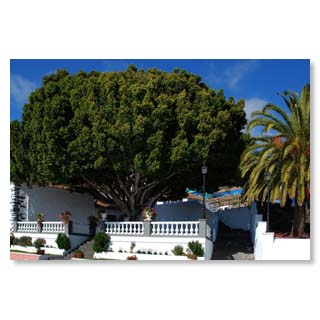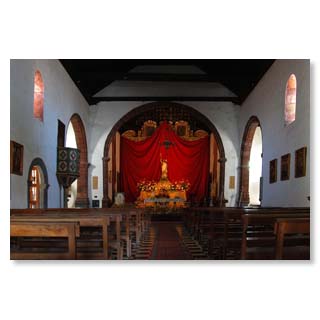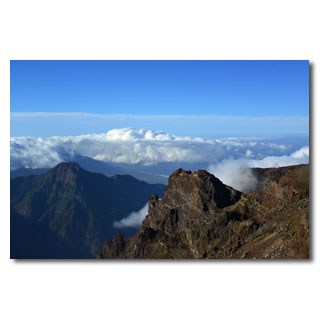Tijarafe - the beginning of the beautiful north
The municipality of Tijarafe stretches northwest of the Caldera, from'Mirador el Time' to Tinizara. The landscape is lovely green and marked by many thousands of almond trees, as well as the typical island dragon trees. Tijarafe became famous for its Devil's Celebration, to which thousands of guests visit the small community every year, as well as the'Smuggler's Bay', to which a short hike is worthwhile.

Even from a distance the visitor sees the majestic laurel tree, which also gives the Plaza of Tijarafe pleasant cool shade.

The church square of Tijarafe

Already in 1530 a chapel was built on today's Plaza, the base for the church'Nuestra Señora de Candelaria

The impressive church of Tijarafe

The'Calle Adios', sung about in a poem on the wall of the house.

Old town idyll in Tijarafe

Since the beginning of the nineties, the island has shone in new colours.

Typical Canarian roof, here formed into a shady patio.

Idyll at the church square

Popular meeting place: The fishing boat of Tijarafe, which unfortunately has recently disappeared.

In a small cactus park the'Cantadores' meet.

The 'Palmeros', as the inhabitants of La Palma call themselves, are very singing…

There are many statues that keep this beautiful culture alive.

Roque de Los Muchachos
The 'Roque de los Muchachos' at 2.426 m is the highest elevation of La Palma and hosts the most important international observatory of the northern hemisphere. Here is a real high mountain climate, in winter the 'Roque', as the locals call it, is often covered with a snow or ice cap. The observatory is the cause of the only light protection law in the world that exists on La Palma and because of which we are protected from neon or laser advertising. On the Roque you will not only find what is currently (2013) the world's largest reflector telescope with a diameter of 10,40 m; it is also the starting point for many hiking trails through impressive rock formations and the most diverse climatic zones. From the roof of the island you can usually see the neighbouring islands of Tenerife (with Spain's highest mountain, the Teide), as well as La Gomera and El Hierro. A visit is worthwhile at all seasons, in winter, however, you should pay attention to the signs that indicate the obligation to use snow chains if necessary.

The highest point of the Roque - old volcanic vents defying wind and weather

Even closer to the stars - view from the Roque into the Aridane valley…

... to the whole splendour of the Milky Way…

… El Paso …

... or to Polaris and the village El Tablado.

Crystal clear air in the morning sun

The domes of the telescopes, landmarks of the Roque

High-tech in an archaic environment

Changing the watch between the sun and moon

Fastest adjustable reflector telescopes

Landmarks visible from afar, seen from El Tablado

Raging cloud formations

barren high mountain vegetation

View into the Aridane valley

Staggered mountain ranges

Tuff and basalt, building material La Palmas

Columned basalt, once formed at great depths under the sea floor, now at lofty heights.

Cloud falls and rich rock colours

The neighbouring island of Tenerife 'above the clouds'

Botanical experimental fields in the high mountains

And again and again fascinating and rapidly changing wok formations

... enjoy …

... and experience.

View to Breña Alta

The Teide, Spain's highest mountain

The broom glows in the evening sun

Between tree line and vegetation-free zone enchants a broom with bright color

And once again we are above the clouds

Cueva de Candelaria - the so-called smugglerbay
Below the city Tijarafe is a vast half-cave in which is a small collection of houses. Today these are used by local people as a weekend or summer residence, for fishing, barbecuing and joint celebrations.
The bay, at the end of which the houses and the landing place for boats is located is protected by small islets from prying eyes - from land prevents the overhanging rock the view of the houses. Thus, the cave used to be able to land "free" goods, which is still remembered today by its nickname

The huge rock face protected against unwanted 'insights'

In winter, the breakers are often so strong that landing is impossible. In summer the bay is a popular place for swimming with locals and guests.

Even in earlier centuries, it took particularly brave and strong men to bring the heavy wooden boats safely ashore.

Please swim here only in absolutely calm summer weather!

The well hidden entrance to the cave on the impressive cliffs of La Palma

Optimum privacy protection on all sides

Caldera de Taburiente
The famous Caldera is the heart of the national park and a must for all La Palma visitors.

Caldera means 'cettle' - with ist 6 km diameter, the Caldera de Taburiente is a truly great kettle!

Protected by steep mountain slopes it offered good protection from time immemorial - against winds from almost all directions, as well as once the Spanish conquerors.

ts dense forests attract hikers from all over the world and offer pleasant coolness even in midsummer.

Due to large temperature differences between the sunlit rock faces and the sweeping north-east trade wind, often rapidly changing weather phenomena can be observed.

Thus the Cumbre carries from time to time a white decoration, while at the entrance of the Caldera cacti and tropical fruits prosper

Inside the erosion crater thrives the Canary pine, an endemic species whose indestructible wood can be found in almost all of the island's historic houses.

Water-bearing streams provide lush green all year round

The Cumbrecita forms the southern boundary of the caldera and is easily accessible by car for a shorter hike.

© 2012 by Bernd y Nadja Blume. Copias de los textos o fotos, igual que sean digital o imprimido sólo son permitido con la licencia por escrito de los autores.









